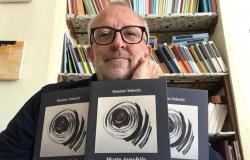Alfiero Nena loved truth and peace because he loved beauty. This is his perennial message to me and to all of you. With these words concluded Cardinal Salvatore De Giorgi’s substantial speech at the study conference in the Aula Magna of the LUMSA University of Rome on 25 May 2024, on the art of the great artist.
The driving force of the day was the presentation of the monograph entitled: Alfiero Nena, selected works 1955-2020 edited by the art critic Luca Nannipieriwith a preface by the Cardinal Angelo ComastriVicar General Emeritus of His Holiness for the Vatican City, and of the Bishop Assessor of the Holy Father for Consecrated Life Daniele Bibbiari, published by Campisano editore. Complete with an English translation kit edited by Dr. Roberta Maria Amendola. The prestigious work and the study day were promoted and organized by the Fidia Center – Alfiero Nena Museum and by his heirs, in order to give new light to the figure of the sculptor Nena born in Treviso in 1933 and died in Rome in 2020 in the IV Municipality where he lived for sixty years.
The study day, which took advantage of the patronage of the Municipality of Rome IV Municipality, began with the moving presentation of the figure of the sculptor by Luigi Matteo curator of the Nena Archive followed by the intervention of the Cardinal and Archbishop emeritus of Palermo Salvatore De Giorgi.

They then took the floor Maurizio Rossi replacing the president of the IV Municipality of the Municipality of Rome Massimiliano Umberti, prof Anna Paola Tantucci president of EIP Italia (Peace Instrument School) and Mons Renzo Giuliano parish priest of the Basilica of St. Mark in Rome and personal friend of the late sculptor.
This was followed by a speech by the critic and art historian Luca Nannipieri who edited the monograph published only a few days ago. A lectio magistralis which will be taken into account in the future when talking about Nena. In the presentation made at the Aula Magna of LUMSA University the critic was guided by some key concepts, the same ones that pushed him to accept the request for Giorgio Nena on behalf of the heirs, to discuss the art of the great sculptor: the concepts of absence, presence, sharing and participation of the people.
He began with beautiful and important reflections on the great sculptor who passed away such as the one reported in the preface by Cardinal Angelo Comastri: “Nena is a true theologian through art”. And Nannipieri wanted to support the assertion by focusing on the astaurotic crucifix, without the cross of the Christ Lux mundi placed since 1990 in the basilica of S. Maria del Popolo. “…the wood of the Cross disappears and becomes a sunburst, but the rays of the sun, of the Resurrection, do not come from the sky, but from below, from the rock, radiating upwards. Nena represents Christ both as a witness to mortal life and as a longing for immortal life. A Jesus burdened with his pain, but with his hands and arms not overcome by pain, but rather raised” (page 20 op. Cit.).

To our Western culture steeped in sacred art, accustomed to seeing Christ on the cross, Nena presents a crucified and resurrected Christ at the same time. As if to say that the cross allows us to imagine it, as if it were there, but its message quickly tends towards the resurrection, without which our faith would be in vain as Paul of Tarsus states without hesitation. The Christ lux mundi, in its formal perfection wants to underline that Christ, prototype of the new man, could only be simply “beautiful” as in the best canonical tradition of Christian iconography. Not a Christ to be interpreted following abstruse artistic currents. That statue, placed in a basilica-museum where no other works had entered for two hundred years, cannot be a divisive experiment but one of complete sharing. We need that image because the more beautiful it is, the more it helps us achieve the invisible. The speaker then focused on another singular reflection. The absence of the cross in Lux mundi makes us think of other important absences. They are the people who are missing in the iron work”Deposition” today preserved in the Treasure Museum of St. Peter in the Vatican. Nena focuses solely on the desolation of the figure of Christ and leaves us only to imagine the mourning of the people around Him such as the Marys, Joseph of Arimathea, John, taking for example the image of the deposition of the Cathedral of Parma or Vicopisano projected on the giant screen . Yet “… this too is a choral work even if you can’t see the people. The artist removed them and the result is very effective because we don’t see those figures but we feel them. And this happens because we have within us the richness of the heritage of previous sacred art.
As in the case of the Madonna of Capri. Without posing any formal problems, Nena interpreted the desperate prayer of the sailor in the stormy sea who turns to the Madonna del Soccorso. When he leaves in the morning on a boat with a difficult sea but with children to feed, he entrusts himself to Her. It is not recklessness, it is trust, it is faith in the Madonna of Help who will not abandon him. It is for him that Nena sculpted a Madonna which, despite her size, retains all the beauty of a mother and her tenderness towards the child in her arms. “…Monumental Madonnas, monumental statues – reiterates Nannipieri – to be such they must be canonical, there cannot be absolute experimentation when a work is made a reference for a community. Nena understood this very well; if you had made a divisive work it would not have been a reference work. In the absence of respect for the tradition of the artistic canon, the work is not understood or is contested; there are numerous examples. The Madonna of Nena creates partnership, sharing, not conflict”. As amply attested by the mobilization of the people of Capri who came, on 1 August 1979, by coach to the blessing of the large statue by Pope John Paul II in St. Peter’s Square. And the same crowd flocks, a month later, to the top of Monte Tiberio for the placement of the statue, walking, young and old, along a not at all easy sheep track that climbs up to the ruins of Villa Jovis for at least ¾ of an hour .

We have summarized and fragmented the salient points of the conference. Suggestions for further studies on the art of the great Treviso sculptor. Among the final speeches, that of the count was much applauded Carlo Piola Caselli who in 2016 delivered the award scroll into Nena’s hands Fra Angelico and that of the architect. Francesco Cefalo who wanted to bring the Lux mundi of Nena, magnificent emblem of the face of Christ in contemporary art, at San Giovanni in Laterano in the conference in preparation for the great Jubilee of 2000.

Special thanks go to the students who took care of the welcome. They are all from “Enzo Rossi” Art School of Colli Aniene-Tiburtino where Alfiero Nena taught for many years and were accompanied by prof Lucia Lo Buono which has been carrying out the PCTO between the high school and the Nena Museum for two years. It is worth highlighting the presence of many artists and Nena’s many friends among the audience. With their presence, their affectionate participation, they wanted to bear witness to an act of kind homage to the great sculptor who passed away.
Was this article helpful or interesting?
Support Abitareroma Click here! ↙
write a comment










